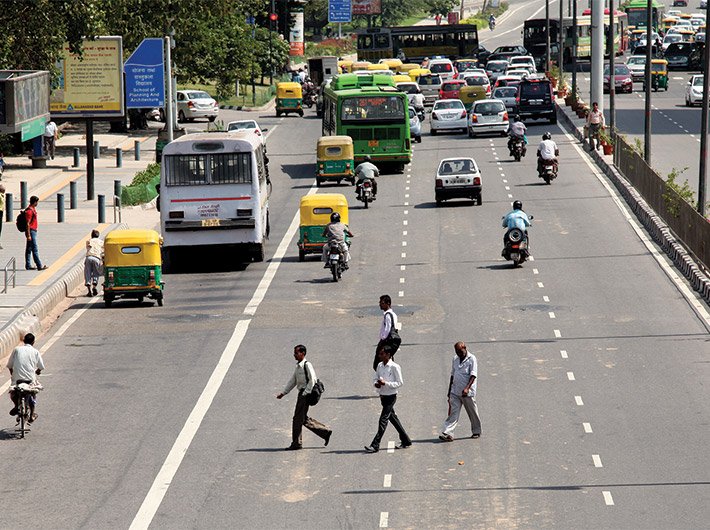The government is aiming for an overhaul of road safety laws. As desperately as it is needed, are we aiming too high?
Did you know that as per the existing road safety law, it is mandatory to wear a seat belt in a moving car? And, it is mandatory even if you are in the rear seat?
Chances are you answered ‘yes’ to the first and ‘no’ to the second question. It isn’t your fault. Even the traffic police will flag you down only if you are not wearing the seat belt on the driver’s seat or on the front passenger seat – never when you are in the back seat.
The government proposes a complete revamp of road safety laws in India. The draft road transport and safety bill, 2014 is already on the ministry of road transport and highways’ website, seeking feedback from the general public. But do we need a law proposing '25,000 fine for drunk driving when we do not have enough breathalysers?
Or could the mandatory wearing of belt on the rear seat rule be enforced when most of our vehicles do not have one?India alone accounts for 10 percent of global road traffic deaths, says Amit Bhatt, strategy head (urban transport)at EMBARQ, a not-for-profit initiative of the Washington-based environmental think-tank World Resources Institute (WRI). “According to official data, the annual road traffic deaths in India are 1.4 lakh, but as per the World Health Organisation (WHO) estimates, the figure is more than 2.25 lakh. Despite the under-reporting, India is at number one in road traffic deaths,” says Bhatt.
Under the Motor Vehicles Act, safety is only restricted to vehicles. But road safety is a multi-dimensional issue. It is governed by the vehicle, user, infrastructure and environment. Bhatt rues that there is no comprehensive legislation for road safety. But the new road safety bill can be a game changer. The bill has proposed an ambitious target of reducing 2 lakh deaths due to road accidents in first five years, which constitutes 25 percent of the total traffic deaths. “It is heartening to see that the government has set an aggressive and a progressive target,” says Bhatt.
Highlights of the bill
It proposes the creation of three lead agencies: national authority for road safety, national transport and multimodal coordination authority and state transport authority
It has set targets to reduce the number of fatal road accidents
Strict penalties for offences involving children
Detailed impairment test for drunk driving
Roadworthiness tests for all cars and two-wheelers every five years
Unified vehicle registration system and registration to be linked with insurance, vehicle offences, and vehicle fitness
Private participation in vehicle fitness testing
Impetus for bus rapid transport (BRT) and intra-city transport and multi-modal integration
Provisions for NMT and pedestrian bicycle infrastructure
Emphasis on safety of schoolchildren/women/persons with disability
Rationalisation of public transport permits
Introduction of standard crash investigation procedure with detailed accident investigation reports
But how much of the target is realistically achievable?
Bhatt is concerned about the implementation aspect. The bill, he says, has “all the right intentions”. The “only caveat” is whether it would be made into a law, and then implemented properly. For now, the government has sought comments from various stakeholders, after which it will be presented in the Lok Sabha. Bhatt is apprehensive that vested interests might dilute the spirit of the bill.
The positives
The bill aims to bring in a lot of professionalism and integration in multiple transport systems. It proposes to set up three authorities – national road transport and multimodal coordination authority, vehicle regulation and road safety authority of India, and highway traffic regulation and protection force. These authorities will have expertise and will look at transport on a continuous basis, which is absent under the current legislative framework.
OP Agarwal, director general, Institute of Urban Transport (India), says it is extremely important to have similar agencies at the city level. “Without a unified metropolitan transport authority we cannot improve our transport system. Today we have the metro, buses and other public transports functioning on their own without any coordination with each other. The expansion plans of each should be decided by a unified body,” he says.
According to Agarwal, urban metropolitan development authorities will be empowered not only by having them as part of the law but also routing the money through them. “If Delhi Metro wants to expand and wants money, it should be given through the unified authority. It gives the authority the power to enforce its plans,” he says.
Praising the unified driver licensing system proposed in the bill, Bhatt says the current process of issuing licence is not very scientific. “The bill talks about participation of the private sector. By using IT, the human interface can be reduced and people can be screened more easily. Use of technology will enable a disciplined traffic,” he says.
Licensing is a public function but private testing centres can be set up to develop and manage the database. “But the authority to access that database should be a public function. It should only be a public agency that decides whether to issue a licence or not,” says Agarwal.
There are 70 lakh commercial vehicles in the country, of which 20 lakh vehicles do not have insurance. Worse, there is no method to track them. Tracking is essential to control the quality of vehicles on road. According to the existing law, all vehicles have to apply for a fitness certificate every two years. But in India, the annual capacity to issue certification is only 10 lakh. Here, says Bhatt, participation of the private sector will be important. “Capacity cannot be built overnight but the work can be shared with the private sector,” he says.
According to Ashvini Parashar, executive vice-president (business partnerships), Delhi integrated multi-modal transit system (DIMTS), the process of test application of vehicles and recall of vehicles is not ingrained in the legal system. “There is no centralised system which tracks vehicles and erring drivers when they move to another state. The system will work well when communication is good throughout India. To keep records at the central level with data gathered from all states will involve software and technical aspects. It is going to be a Herculean task,” he says.
Things will become a lot more transparent if a central database maintaining a record of the driving performance throughout the country is created.
Agarwal warns that the bill is not a panacea for all ills. “Let’s not believe the bill will solve all the problems but it is a step in the positive direction,” he says. “At present not all the states are issuing driving licences using Vahan and Sarathi (software applications used by the local transport authorities for issuing vehicle registration certificate and driver’s licence, respectively). For them, it will be a quantum leap.”
Without a unified metropolitan transport authority we cannot improve our transport system. Today we have the metro trains, buses and other public transport functioning on their own without any coordination with each other.
OP Agarwal, director general, Institute of Urban Transport (India)
The two important components of road safety is transport vehicles and transport infrastructure, but road infrastructure is not covered under the Motor Vehicles Act. The law has to marry these two. It is not yet known what the powers of the proposed authority will be over the states. The state transport department issues a driving licence and it has no linkage at the national level. To ensure efficiency of the system, data has to move freely across states, say experts.
The omissions
The bill has not clearly elaborated on the implementation of the proposals. Besides car users, pedestrians and cyclists too have to be brought under the ambit of road safety. The modal share of people using public transport or cycling is much higher than people using cars. But the bill does not mention how many pedestrian or cyclist accidents it aims at reducing. Neither does it talk about a zero tolerance policy.
Last month, the ministry of road transport and highways came up with a notification that puts a speed limit up to 100 km per hour on cars plying national highways, and 80 km per hour for trucks and trailers.
In India, there is no restriction on how a city is growing. Initially, Delhi meant only the Lutyens zone and its surroundings. Now, the national capital region (NCR) has extended up to Bharatpur, and highways are lined with villages.
Ruchita Bansal, programme officer, right to clean air campaign at the Centre for Science and Environment (CSE), says the bill does not talk about limiting speed. She says: “Speed limits have to be changed according to land use around the area. Whenever we make roads, we always look at the number of cars on that road; we never look at the number of pedestrians or cyclists using that road. It (the bill) is not talking about the design of roads giving equity to all road users.”
Moreover, Bansal says, most cars on Indian roads are unsafe. “All small cars are unsafe and manufacturers need to be challenged. To reduce accidents in the next five years these are the measures which should be implemented and a timeline should be drawn for things they (the government) plan to achieve every year,” she adds.
The bill has all the right intentions. The only caveat is implementation.
Amit Bhatt, strategy head (urban transport), EMBARQ
Bansal says the government must not repeat the mistakes of the Jawaharlal Nehru national urban renewal mission (JNNURM). “Whenever a city proposed a transportation project, it was more about making a flyover, improving the road infrastructure or widening a road. There was nothing about making good footpaths or cycle tracks or improving connectivity between two modes of transport. Only 10-15 percent of the money went into Metro and BRT and some into making parking infrastructure. Wider roads do not solve the problem of congestion. Despite so many flyovers in Delhi we still have a lot of congestion because we have not been able to restrict the number of cars,” she says.
Parashar says to ensure safety a check has to be kept on the sale of second-hand vehicles as well. Many a time, the owner replaces original parts with spurious parts, either consciously or unconsciously. This is missing in the Act. “There should be a certified agency at the national level to decide if the product is good enough for second-hand sale,” he says. “The format for detailed accident investigation report in the bill must be checked by a lawyer so that the accused cannot exploit any loophole in it.”
He also wonders why there isn’t any law on enforcement. “There has to be a database of all inspectors in the country, recording the number of challans issued, the number of accident cases resolved by them, etc. There should also be a grading system to understand their performance. Performance is not being measured at the level of the government,” he says.
In the absence of adequate lighting, vehicles often crash into haphazardly-constructed dividers. The government has to take some responsibility instead of passing the buck on to rash driving, etc. Corridor improvement is a good practice, and finding bottlenecks and streamlining them would save more lives.
All is not lost
Despite the misgivings, the bill definitely takes a giant leap towards road safety and transport. “We have a law but we do not have professionals constantly looking after how transport systems are functioning. This bill has given prominence to safety at the level which is much higher than what we have today. There is recognition that safety (or the lack of it) is one of the biggest killers in the world,” says Agarwal. “Safety cannot only be looked at from the point of licensing, policing or enforcement. It has to be looked at from a development perspective than from an enforcement perspective.”

